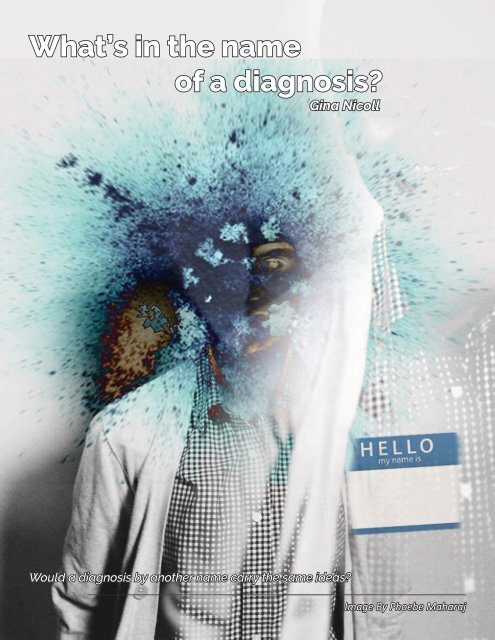Culture & Identity
Create successful ePaper yourself
Turn your PDF publications into a flip-book with our unique Google optimized e-Paper software.
What’s in the name<br />
of a diagnosis?<br />
Gina Nicoll<br />
Would a diagnosis by another name carry the same ideas?<br />
Image By Phoebe Maharaj<br />
Minds Matter Magazine Volume III Issue I <strong>Culture</strong> & <strong>Identity</strong><br />
Imagine you are meeting Hiromi, a 22-yearold<br />
Japanese man. He has integration disorder,<br />
which can affect his thoughts and perceptions.<br />
Sometimes, what he experiences does<br />
not reflect reality. But with the right help, he<br />
can recover and lead a normal life.<br />
What is your first impression of Hiromi? Would<br />
you be open to being friends with him?<br />
Would your view of him change if you knew<br />
he actually had schizophrenia?<br />
This thought experiment is the reality<br />
in Japan. In 2002, the Japanese medical system<br />
changed Seishin-Bunretsu-Byo - which<br />
translates to “mind-split disease” - to Togo-Shitcho-Sho<br />
or integration disorder. Mindsplit<br />
disease is the same diagnosis as schizophrenia,<br />
which comes from the Greek words<br />
for “split” and “mind.”<br />
Along with the name change, Japanese<br />
psychiatrists created new associations for integration<br />
disorder. It is no longer a debilitating<br />
and hopeless disease leading to decline and<br />
discrimination. Under a vulnerability-stress<br />
model, they rebranded it as a disorder where<br />
recovery is possible with the right medication<br />
and support.<br />
If you hear “schizophrenia” and think<br />
of threat and aggression, you are not alone.<br />
A 2001 study of Quebecois individuals found<br />
that 54 per cent of respondents considered<br />
people with schizophrenia dangerous and violent.<br />
However, people with schizophrenia<br />
are 14 times more likely to be victims of violence<br />
than perpetrators of it. Reports also<br />
indicate that 99.97 per cent of people with<br />
schizophrenia are not convicted of serious<br />
violence in a year.<br />
Our public perceptions of schizophrenia<br />
are not just wrong; they are actively<br />
harmful. A 2014 study examined how changing<br />
the name of schizophrenia could change<br />
perception. The study found that treatment<br />
outcomes for schizophrenia are poorer in<br />
the Western world - where only one in three<br />
people with schizophrenia recover - than in<br />
Nairobi, Kenya, where one in two people recover.<br />
One of the main reasons for this is said<br />
to be the stigma associated with schizophrenia<br />
in the Western world.<br />
In a different survey, two-thirds of<br />
people with schizophrenia did not pursue<br />
treatment because of the anticipated stigma.<br />
Another survey cited in the study found that<br />
the majority of Western people with schizophrenia<br />
view the discrimination that comes<br />
from having schizophrenia more negatively<br />
than the symptoms of the disorder itself.<br />
In Japan, before the name of the diagnosis<br />
changed, there were similar associations<br />
between schizophrenia, unpredictability,<br />
and violence. Many doctors would not<br />
inform people of their diagnosis for fear of<br />
inflicting stigma and discrimination, which<br />
would affect their treatment.<br />
Since the name change, the diagnosis<br />
is viewed as less stigmatizing. Within two<br />
years, 33 per cent more people were informed<br />
of their diagnosis, and 86 per cent of<br />
psychiatrists surveyed said the change made<br />
it easier to tell family and friends about the<br />
diagnosis and helped introduce education<br />
23






